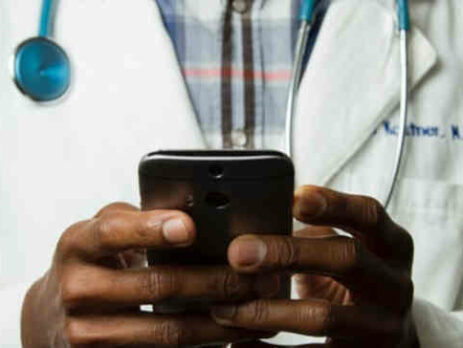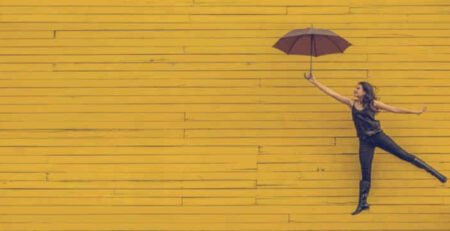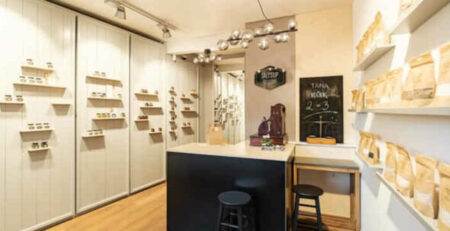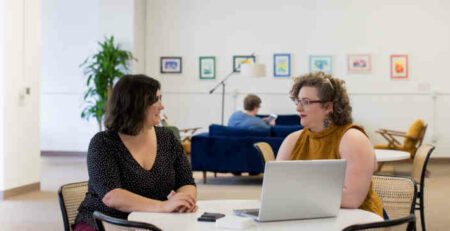Creative Roles in Healthcare for Designers, Web Developers, and Social Media Managers
Healthcare is one of the largest employment sectors and is expected to continue to grow in the coming decades. Although the majority of those new roles are likely to be in healthcare support positions like home care aides and assistants, creatives still have a huge role to play in medical applications.
User-centered design often fixates on individuals using apps, websites, and shopping in stores. Healthcare users are more frequently highly trained and use digital applications that have to be accurate, seamless, and unobtrusive. Information has to be found and transmitted lightning-fast because patients depend on it for some of the most impactful decisions in their lives.
Although there is more pressure and everything is more fast-paced, working in healthcare can be highly rewarding for creatives who want to make a strong impact on their users. Read on to find out more about the role of creatives in healthcare jobs.
Creativity in Healthcare
Healthcare isn’t limited to hospitals and doctors’ offices. As software and connectivity increase, more and more people are using telehealth to address non-emergency medical needs. Everything from scheduling appointments to receiving prescriptions and even some biometric screening can be done from an app or a laptop.
All that is to say that creatives may not even enter a hospital or doctor’s office when they’re working for a healthcare company. And patients frequently enjoy not having to see a doctor when they can get what they want via telemedicine.
There’s virtually no limit to creativity in healthcare. More convenient products can expand access to healthcare by limiting reliance on physical space in medical buildings. Digital interfaces and databases that work faster may increase the overall quality of care, make medical professionals’ jobs easier, and most importantly make the patient experience safer.
One of the most important healthcare-specific creative roles is that of the healthcare designer. They’re responsible for the overall design of a hospital, from the layout to the use of signage so that patients and employees can navigate the building with ease. We can take a closer look at the role of a healthcare designer to find out what opportunities await other creatives in the healthcare field.

What is a Healthcare Designer?
As with other kinds of UX/UI designers, the role of a healthcare designer can and often does vary from company to company. Broadly speaking, they are responsible for inventing and executing projects that make things easier for the patients and the providers.
More specifically, a healthcare designer could be involved in renovating the interior of a hospital, building an app for appointments or prescriptions, or creating tools for patients to communicate with medical professionals or loved ones during a hospital stay. Although a healthcare designer relies on many of the same skills and theories that any other UX designer would, they also need to be more specialized.
Medicine and other healthcare jobs are complicated and require very specific knowledge. While you may not need a medical degree to be a healthcare designer, you should know the ins and outs of the patient and provider experience so that you can identify pain points and build products that solve those problems.
User research goes a long way in informing designers about the users they cater to. An understanding of the particular practice area can also help. For example, a healthcare designer working in a chiropractor’s office doesn’t have to be able to identify back problems in a patient, but they should understand what happens during an appointment to make the chiropractor’s job easier.
Other Creative Roles in Healthcare
Here are a few other ways creatives can work in healthcare.
- Graphic Designers
Hospitals and healthcare companies need logos and clear signage the same way companies do. Patients have to be guided through incredible amounts of information and clean, easy-to-read graphics are very helpful tools for doing so.
Beyond that, graphic designers in healthcare can also help improve branding on the provider side. This boosts marketing for elective procedures and helps improve patient trust. Strengthening the public perception of a medical brand increases patient engagement, leading to more positive health outcomes.
- Web Developers
Everyone is pushing to get online and healthcare is no exception. Patients want to be able to get their routine medical needs met with a minimum of in-person interaction and hospitals need to be able to provide that service and get more resources into patients’ hands before they ever come to a hospital or doctor’s office.
Web developers can help make engagement with medical providers less intimidating. They also give providers greater access to information on demand, which will facilitate more targeted care faster than older methods allowed.
- Content Writers
Providers and health insurance companies have a huge need to present loads of complicated information to patients and customers in an accessible way. Businesses have been embracing the more informed modern customer base for a while now by employing content writers to create informative articles that will show up on a web search.
Accessing care and understanding risks and benefits often involves many considerations and tons of information that is brand new to patients. Providers may also need to be taught about how insurance works and vice versa for employees of insurance companies. Effective content writers inform all parties involved.
- IT & Back-End Development
Health records and financial data are gathered and stored for years in the majority of healthcare applications. Not only does it need to be held onto and still be quickly retrievable tens of years later, but it also has to be stored securely. Creatives who know how to protect user data are integral to the successful operation of hospitals and medical research companies.
Patients have to feel that their information and medical records are safely stored or else they will be discouraged from allowing that information to be gathered in the first place. Doctors and other providers need to be able to find individual data quickly and also see aggregated data that’s organized in a convenient way.
- Marketing
It might sound a bit strange that hospitals or other medical providers would need to market themselves, but bear in mind that at its essence marketing is just broadcasting information. People might already be aware of the local emergency room as a matter of safety, but they won’t know where the nearest allergy clinic is unless they see an advertisement for it.
When it comes to public health initiatives like screenings or vaccinations, letting people know where to go to have services rendered is vital to successful policy rollout. Marketing professionals are also well-suited to create referral systems so effective providers can keep their doors open.
- Social Media Managers
Just like every other organization, medical providers are creating social media accounts to disseminate information and allow users to contact them directly with questions and to resolve customer service issues. Providers without any social media presence are viewed as less legitimate and people will have less faith in their services.
Social media managers can give a human face to healthcare organizations that are all too often too large and opaque for everyday people to reach and form an opinion about. In tandem with marketing professionals and designers, creatives who know how to run social media accounts can help make healthcare less confusing and encourage more access by a greater number of people.
- Product Designers
Healthcare is one of the best opportunities for creatives to develop physical products. While most of the consumer market is currently concentrated on crafting new digital products like apps and websites, doctors and other providers still have a massive need for physical tools to help them do their jobs.
That might be something simple like a thermometer or it could be a larger piece of equipment like an MRI machine. Whatever the case may be, providers need product developers to create a seamless and enticing experience so that they can render their incredibly important services as efficiently as possible. Product designers have more opportunities to showcase their creativity in healthcare.
Empathy in Creative Healthcare Roles
Empathy is a central component of design thinking and it’s also one of the main motivators for people who look for careers in healthcare. Doctors and nurses care a great deal about their patients and protecting against harmful diseases. Similarly, creatives who care about helping people through some of the most difficult challenges life has to offer find that they can make a strong and visible impact in healthcare.
Not only do creatives need to care about people who might be in health crises, but they also have to consider providers and what they need to provide the best possible services to their patients. A great example of empathy with healthcare providers is the widespread use of ads to thank front-line care workers throughout the health crisis that began in early 2020.
Identifying problems and coming up with solutions that will resolve them requires an intimate understanding of users. When it comes to healthcare, that typically involves getting up close and personal with very serious issues and, in some cases, great suffering. For creatives of a certain disposition, this is a rare opportunity to make a measurable impact and help people directly.
What Do Creatives Need for a Job in Healthcare?
Some people have been able to find creative work in healthcare jobs without an undergraduate degree in a related field or studying at a portfolio school. This typically requires an entry-level position or internship and lots of on-the-job education and practice. For the majority of creative jobs in healthcare, a degree will help you get hired faster and at a higher starting position.
But that doesn’t mean you need to double major in design and biology to get hired by a medical company or a hospital. The specifics of healthcare can be learned on the job through particular projects as long as you have the requisite expertise in your creative field.
As long as you’re ready to be in an incredibly fast-paced environment and work on new projects far more frequently than you would in other areas, you’ll be happy as a creative in healthcare. Providers, patients, and other stakeholders face intense pressure and incredibly limited timelines when they’re trying to resolve health issues and that duress usually transfers to creatives who endeavor to problem-solve in this field.
That intense pressure also leads to greater payoffs at a higher frequency. The scope of responsibility in healthcare gives creatives the chance to make the kind of impact that simply isn’t possible in purely commercial projects.
Although you may be able to get by without a degree, you will need a portfolio to demonstrate your work and creative process. If you can’t find work on projects that will help build a portfolio, consider taking on some voluntary work and drafting mock projects on your own time so that you can showcase your creativity in healthcare applications.
Should I Specialize in Healthcare?
A common concern amongst creatives trying to land their first job or progress in their careers is that they’ll start to specialize their skillset only to be laid off and find themselves unable to find another role in the same field, forcing them to reskill.
Since healthcare is a large and growing field, creatives don’t have to worry about that too much. Plus, since so much of the jargon and needed experience is so complicated, it would behoove your career to specialize in medicine and related applications. Understanding the particulars of patients and providers will allow you to create projects that are far more useful and effective.
Plus, there are so many niche fields within healthcare that specializing in it still affords creatives ample opportunity to make lateral changes without having to begin their skill-building back at zero. If you want to make a lateral move from hospitals, you might be able to find a smaller clinic or move to telemedicine applications without sacrificing any of the experience you’ve already earned.
One of the many things that set healthcare jobs apart from creative work for more traditional companies is that you’re more likely to be dealing with donors. The good news is that these donors usually have some kind of personal attachment to the cause and may be less cutthroat than corporate stakeholders. However, keep in mind that at the end of the process is someone struggling with health issues, so a greater sense of urgency is likely as well.
The Future of Healthcare
As artificial intelligence is increasingly integrated into healthcare research and records maintenance, designers can look forward to even more jobs opening up in the field. There’s no telling for sure what shape these jobs will take, but an aging population in most western countries and the fast pace of technical innovation appear to guarantee that there will be plenty of work to do in healthcare for years to come.
Governments and charities by and large aim to increase the availability of healthcare for their constituencies and beneficiaries. Developments in the transportation and communication industries will hopefully increase the number of people who can access healthcare for both urgent and non-emergency purposes in the future. Creatives will be needed to facilitate that increase alongside doctors and other medical professionals.
From a professional standpoint, working in healthcare seems to promise a career path, solid pay, and plenty of room for developing your creative skills. On a personal level, creatives have the opportunity to see the real-world impact of their work in a way that very few other fields can offer.

Conclusion:
From the tools doctors use to the databases where medical records are stored, communication technology and the digitization of old methods are both creating new chances to be creative in healthcare.
As much as regular businesses and other systems need to explain complicated information to their users, that need is even more pronounced in medicine. To make things even more challenging, the people who need to receive this information are quite likely going through some of the most difficult times of their lives.
This presents a dire need as well as many unique opportunities for creatives. Although the work is fast-paced and highly technical, the payoff in terms of both salary and a visible impact on society is higher when you’re working in healthcare. If you’re looking for a new job or trying to land your first one, healthcare jobs certainly merit strong consideration.












